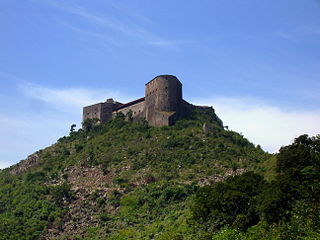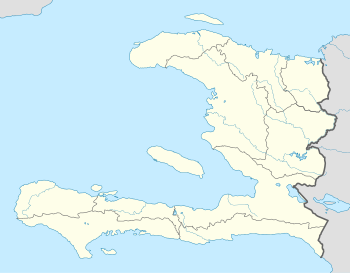
The Citadelle Laferrière, commonly known as La Citadelle, is a large early 19th-century fortress located in Milot in Nord, Haiti. It is situated on the Bonnet à l'Evêque mountaintop located approximately 8 kilometres (5.0 mi) uphill from the town of Milot, 27 kilometres (17 mi) south of the city of Cap-Haïtien, and 15 kilometres (9.3 mi) southwest of the Three Bays Protected Area.

The Palace of Sans-Souci, or Sans-Souci Palace, was the principal royal residence of Henry I, King of Haiti, better known as Henri Christophe. It is located in the town of Milot, approximately five kilometres (3 mi) northeast of the Citadelle Laferrière, and thirteen kilometres (8 mi) southwest of the Three Bays Protected Area. Being among the first buildings constructed in a free Haiti after the Haitian Revolution, the Palace and the neighboring Citadelle, are Haitian icons and global symbols of liberty, and were inscribed on the World Heritage List in 1982.
The Massif de la Hotte is a mountain range in southwestern Haiti, on the Tiburon Peninsula. About 2.5 million years ago, Massif de la Hotte was separated from the Massif de la Selle by a deep, wide sea channel, and formed a separate island. This resulted in a hotbed of endemism in la Hottes bird, plant, and reptile communities. The Massif de la Hotte is subdivided into the Oriental la Hotte in the East, the central la Hotte and the Occidental la Hotte on the Western tip of the Tiburon peninsula. The Occidental la Hotte is relatively remote and is one of the most biologically diverse and significant areas of all of Hispaniola. It also supports some of the last stands of Haiti's dense cloud forest on its peaks.
Tourism in Haiti is an industry that generated just under a million arrivals in 2012, and is typically one of the main sources of revenue for the nation. With its favorable climate, second-longest coastline of beaches, and most mountainous ranges in the Caribbean, waterfalls, caves, colonial architecture and distinct cultural history, Haiti has had its history as an attractive destination for tourists. However, unstable governments have long contested its history and the country's economic development throughout the 20th century.

Albert Mangonès, was a Haitian architect.

On April 12, 2020, at 3 AM, a structure fire broke out beneath the roof of the Royal Chapel cathedral in Milot, Haiti. By the time firefighters arrived to stop the fire from spreading, the dome of the cathedral had collapsed and the rest of the building was already badly burnt. The dome collapsed, causing the loss of everything inside the building.

National History Park is a national park in Haiti established on 1968. It is located in Milot. It was declared as a UNESCO World Heritage Site in 1982.











